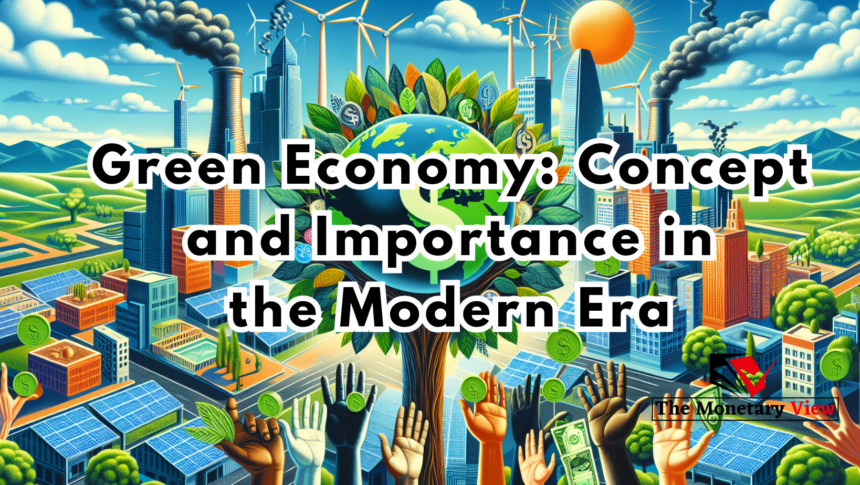The concept of a green economy is gaining increasing traction as societies and businesses strive to address environmental challenges while promoting sustainable economic growth. This article explores the concept of a green economy, its key components, and its significance in the modern era.
1. Understanding the Green Economy
A green economy is an economic system that aims to achieve sustainable development without degrading the environment. It focuses on promoting economic growth while reducing carbon emissions, conserving natural resources, and minimizing environmental impact. The green economy integrates economic, environmental, and social goals to ensure long-term sustainability.
Key Principles of a Green Economy:
- Sustainability: Ensuring that economic activities do not compromise the ability of future generations to meet their needs.
- Resource Efficiency: Optimizing the use of natural resources to reduce waste and environmental harm.
- Low Carbon Emissions: Reducing greenhouse gas emissions through cleaner energy sources and technologies.
- Social Inclusion: Promoting equitable access to resources and opportunities, ensuring that the benefits of economic growth are shared broadly.
2. Components of a Green Economy
Several components contribute to the development of a green economy:
- Renewable Energy: Investing in renewable energy sources such as solar, wind, and hydro power to reduce dependence on fossil fuels and lower carbon emissions.
- Energy Efficiency: Implementing energy-efficient technologies and practices in buildings, transportation, and industries to reduce energy consumption.
- Sustainable Agriculture: Adopting agricultural practices that conserve soil, water, and biodiversity while minimizing the use of harmful chemicals.
- Green Infrastructure: Developing infrastructure projects that enhance environmental sustainability, such as green buildings, sustainable transportation systems, and waste management facilities.
- Circular Economy: Promoting recycling, reuse, and the reduction of waste by designing products and processes that minimize environmental impact.
3. Importance of a Green Economy in the Modern Era
The transition to a green economy is crucial for several reasons:
- Environmental Protection: The green economy helps address pressing environmental issues such as climate change, deforestation, and pollution. By reducing carbon emissions and conserving resources, it contributes to the protection of ecosystems and biodiversity.
- Economic Resilience: Investing in green technologies and sustainable practices can enhance economic resilience by creating new industries and job opportunities. Green sectors are often less susceptible to fluctuations in resource prices and can drive innovation and growth.
- Health and Well-being: Reducing pollution and improving environmental quality can lead to better public health outcomes. A cleaner environment helps prevent health problems related to air and water pollution, benefiting overall well-being.
- Global Competitiveness: Countries and businesses that embrace green practices can gain a competitive advantage in the global market. As consumers and investors increasingly prioritize sustainability, adopting green practices can enhance reputation and attract investment.
4. Challenges and Opportunities
While the green economy offers significant benefits, it also presents challenges:
- Transition Costs: Shifting to a green economy requires upfront investment in new technologies and infrastructure. Governments and businesses need to balance these costs with long-term benefits.
- Policy and Regulation: Effective policies and regulations are needed to support the transition to a green economy. This includes setting standards, providing incentives, and creating a supportive regulatory framework.
- Innovation and Technology: Continued research and development are essential for advancing green technologies and practices. Collaboration between governments, businesses, and research institutions is crucial for driving innovation.
Opportunities in the Green Economy:
- Job Creation: The green economy can create a wide range of job opportunities in renewable energy, green building, sustainable agriculture, and environmental management.
- Investment Growth: There is increasing investment in green technologies and sustainable practices, providing opportunities for financial returns and growth.
- Enhanced Quality of Life: Adopting green practices can lead to a higher quality of life by improving environmental conditions and promoting sustainable development.
5. Conclusion
The green economy represents a transformative approach to achieving economic growth while safeguarding the environment and promoting social equity. By focusing on sustainability, resource efficiency, and low carbon emissions, the green economy offers a pathway to a more resilient and equitable future. Embracing green practices is essential for addressing global environmental challenges and ensuring long-term prosperity for all.







